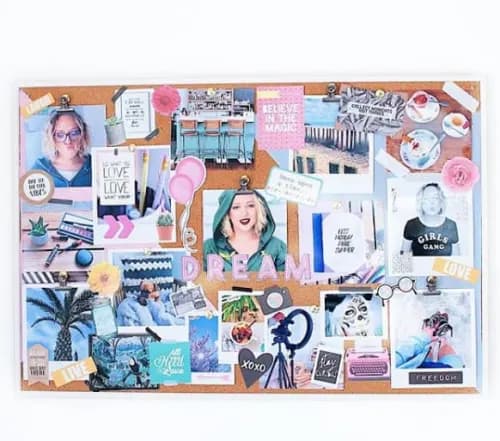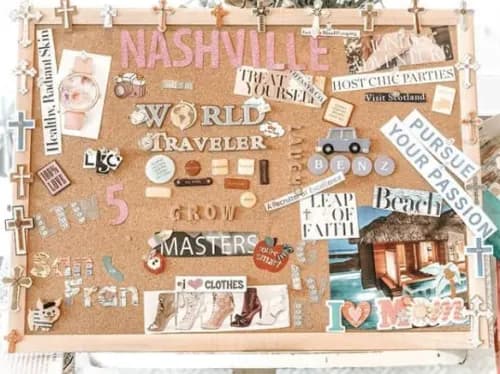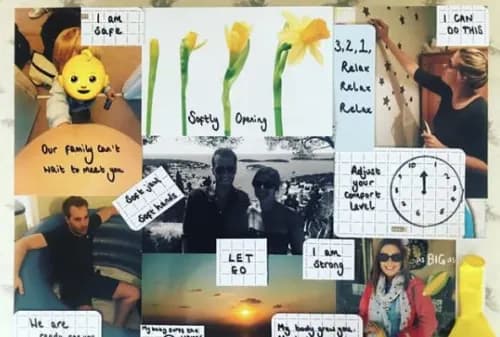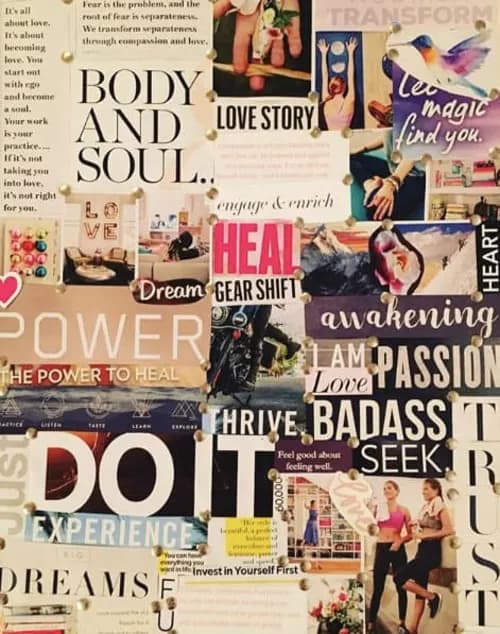Vision Boards: Examples, Steps to Making One and More
Behind every great accomplishment is a vision. And behind every vision is a “why?” Vision boards help manifest goals by combining an individual’s values and intentions into a powerful vision, then providing the perfect tool for meditating on that vision to produce results. Here’s how to make a powerful vision board to attract your ideal life.
How does a vision board work?
A vision board is a visualization tool — usually a collage of words and pictures that represent your goals or dreams. They are thought to activate the Law of Attraction, or the idea that you will attract into your life whatever you focus on. In other words, the Law says that if you stay focused on good and positive things in your life, you will attract more positive things. A vision board helps you visualize and focus on your goals and dreams everyday, naturally manifesting them in your life.
A vision board can be made for personal, professional or interpersonal goals. They can be made for a single goal, or a series of goals. The goals can be concrete (say, getting a promotion) or more subjective (maybe being more content or loving yourself more). A vision board can be created individually, or with a trusted person who shares your goals. For example, you and your significant other may create a board for your marriage. Or you and your Co-founder may create a board for your business.
Manifesting with a vision board.
The best way to achieve your dreams is to know what they are, and keep them in front of your mind so that you will always be working towards them. Vision boards help you manifest your dreams by prompting you to visualize your goals (and how to achieve them) on a regular basis.
The focus on your dreams that is prompted by vision boards will train your brain to notice available resources that you might’ve missed before, and will attract the people and opportunities you need to reach your goal. You will naturally feel yourself compelled to take steps to reach your goals when you are visualizing their action steps everyday.
Overall, you will feel a greater sense of purpose in your life when you are working towards your intentions. By channeling your energy into your ideal life — rather than into anxiety or negative thoughts — you will attract positivity and purpose.
What do you need for a vision board?
To make a vision board, you need a clear mind that is centered on your intentions, a positive space to work in and the supplies listed later in this article.
Consider practicing mindfulness before creating your vision board; practicing meditation or yoga will help you recenter yourself and clear external expectations or influences on your intentions.
Additionally, ensure a positive workspace by lighting candles, burning incense, playing music, grabbing your favorite blanket or doing whatever else you need to make yourself feel completely comfortable. Make sure your workspace is big enough to spread out your materials.
Some people prefer to create their vision boards with an important person in their lives, such as a friend or a partner. While the comfort and motivating energy that they provide can be beneficial to your process, ensure that they are not a distraction from your internal goals. Have a conversation with them beforehand to set clear expectations for their role in creating your vision board.
How to make a vision board.
1. Gather your supplies.
To make a vision board, you will need:
A base, such as a poster board, a cork board, a trifold board, an art book or sketchbook, index cards or plain paper.
Magazines, books or other products that can be cut up.
Something to attach the images to your base, like glue, tape or pins.
Pens, markers or paint.
Scissors.
Supplies to dress up your vision board, such as colorful paper, stickers, ribbons or other accessories.
2. Determine your intentions.
Before you get started making the visual board, you must set your intentions. To determine what you want to manifest, ask yourself the following questions. Try to answer these questions in short phrases or single words. The root of the answer is what you truly desire.
What do I want out of life?
What do I value? Who do I value?
What do I need more or less of in your day-to-day life?
What do I wish I had?
How do I want to feel in my day-to-day life? How do I want to feel when I achieve my goals?
Once you have your answers, keep them at the top of your mind. Then, get started on step three.
3. Scout out images and words that appeal to you.
While meditating on your intentions, flip through your books or magazines. Cut out any images or phrases that catch your attention or resonate with you. At this point, the materials do not need to be attached to any of your goals.
If you aren’t finding anything that appeals to you — or if you have a specific vision — feel free to draw, write or create materials for your vision board with your art supplies.
Create materials until you feel content with what you have.
4. Select which materials to include on your board.
Once you’ve cut out or created materials for your board, take a moment to look at each image or phrase. Does it invoke the feelings behind your intentions? If your intention is to spend more time with loved ones, the underlying feeling may be love. If your intention is to develop your dream career, the underlying feeling may be confidence or motivation. Find images that spark that feeling in you, and that bring you joy when you consider the possibilities they represent.
Once you find materials that match your feelings and motivate manifestation, attach them to your base. Then, if you want, decorate the board in a way that cements these feelings. If your intention is to experience more happiness and that intention’s underlying feeling is joy, you may decorate your board with yellow paper or glitter. If your intention is to love yourself more and that intention’s underlying feeling is love or confidence, you may decorate your board with red marker, heart stickers or ribbon.
5. Put your vision board in a positive, visible space.
A vision board is most effective when it is referenced often. It should serve as a visible reminder of your intentions, goals and core values. With these in mind, ask yourself if your vision board would best serve you as something you see every day, or when you need a special reminder of your goals. Then, place your vision board accordingly.
If you’d like to see your vision board daily, consider placing it on a visible wall, near a mirror or near a calendar you reference every morning. If you’d like to see it when you need a reminder of your goals, consider placing it on the back of a door or in an easily accessible closet or storage space. The key is to keep the vision board within arm’s reach for when you need it.
6. Make a list of how you’re going to manifest your goals.
Example vision boards.
This colorful vision board by @severinejenny mixes images from magazines and hand-made materials to create a bright and bubbly vision board. This board elicits feelings of happiness, confidence and relaxation.

This vision board done on cork by @mollyshadeee combines pastel scrapbooking materials, magazine clippings and other decorations to create a bright, open feeling. This board elicits feelings of contentment, wonder and creativity.

@mindfulmammahypnobirthing used this vision board to prepare for the birth of her son. The board elicits feelings of comfort, relaxation and openness that is often associated with new beginnings. She creates these feelings with words of encouragement, lots of yellow hues, and a playful mixed-media aesthetic.

This board created by @thepracticalyogini uses many phrases and magazine clippings to create an ideal vision of health and wellness. This board utilizes pins, bright colors, and bold lettering to elicit feelings of motivation, confidence, and power.

This vision board by @pumpupyourjournal was drawn rather than cut from materials. It is a simple meditation on several intentions, made especially personal by the detailed illustrations.

History.
The Law of Attraction (on which vision boards are based) is ancient. The idea that thoughts manifest realities in the physical world dates back to ancient texts, and appears in many religions. Buddha is cited as saying “all that we are is the result of what we thought.” Similarly, Mark 11:24 cites Jesus as saying: "Therefore I say unto you, What things soever ye desire, when ye pray, believe that ye receive them, and ye shall have them.” Some interpretations of the Hindu karma is built on the same principle as the Law of Attraction — that what you do and think determines your reality.
The Law of Attraction as a New Thought philosophy grew out of the teachings of Phineas Quimby in the early 1800s. Quimby was diagnosed with tuberculosis as a young man, and his medical treatments were not working. So, he began treating himself by changing his mentality on the illness and taking carriage rides around New Hampshire. He regained health, and began preaching the importance of positive thinking.
In the 20th century, there was a surge in interest in the Law of Attraction. Three books on the subject — Think and Grow Rich (1937) by Napoleon Hill, The Power of Positive Thinking (1952) by Norman Vincent Peale, and You Can Heal Your Life (1984) by Louise Hay — were all best-sellers. In 2006, the ground-breaking film The Secret by Rhonda Byrne (which was developed into a book with the same name) brought the Law of Attraction back into the spotlight in the U.S. The film and book received massive media attention, and has sold over 30 million copies.
Vision boards themselves date back to the prehistoric era. Anthropological studies suggest that cave paintings were created by our ancestors to help them envision a successful hunt. Like the broader Law of Attraction philosophy, they became exceedingly popular in 2000s pop culture following The Secret.
Pop culture.
As mentioned, The Secret launched vision boards into popular culture in 2006. Since then, several celebrities have revealed that they are vision board enthusiasts. Perhaps most notably, Oprah has hosted several segments on her hit TV show about vision boards. She has interviewed life coach Martha Beck and television host Steve Harvey about how to create an effective vision board, and even gave a master class on manifestation to the “Wrinkle in Time” cast. One of Oprah’s vision boards reportedly envisioned Barack Obama as President; Obama is reportedly a vision board believer, too. His election committee created a vision board for him on the campaign trail.
Beyonce, Katy Perry and Ellen Degeneres have also shown their support for manifestation. Beyonce’s vision board reportedly featured an Academy Award and used to hang over her treadmill at home. Katy Perry reportedly first made a vision board at age 9, and included a picture of superstar singer Selena. In 2012, Ellen did an entire segment on vision boards on the Ellen show (she was hoping to land on the cover of 'O' by appealing to Oprah's love for the Law of Attraction). Since, she has also interviewed actress Whitney Cummings on her vision board, which featured a photo of Degeneres.
Vision boards can be powerful tools for manifesting your ideal life. They magnify your intentions and motivate you by reminding you of your goals. However, it’s up to you to focus on these goals and attract opportunities. Do so by meditating on your vision as much as necessary, and by focusing your energy on goals that are attainable and contribute to your overall sense of achievement. Positivity begets positivity.
Don’t miss out on articles like these. Sign up!
Why women love us:
- Daily articles on career topics
- Jobs at companies dedicated to hiring more women
- Advice and support from an authentic community
- Events that help you level up in your career
- Free membership, always
